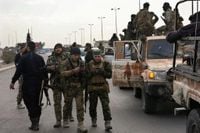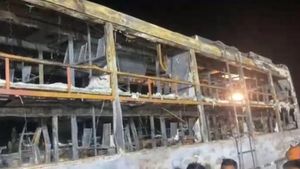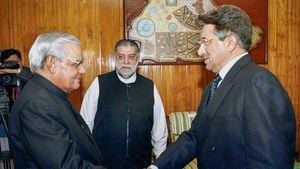Violence erupted in northern Syria’s Idlib province this week as security forces clashed with a French-led militant group in the Al-Firdan camp, highlighting the country’s ongoing struggle to manage the complex legacy of foreign fighters after years of war and shifting alliances. The confrontation centered on Omar Diaby—better known as Omar Omsen—a Senegal-born French national who has long been a prominent figure among foreign jihadists in Syria.
According to The New Arab, the Internal Security Forces of Syria’s Ministry of Interior announced on Thursday that they had reached a truce with the Ghuraba Battalion, a group of French fighters led by Omsen, after days of tension and deadly clashes in the camp near Harem, northern Idlib. The agreement, brokered with the involvement of the Turkistan Islamic Party, included a ceasefire, withdrawal of heavy weapons to military barracks, cessation of inflammatory media campaigns, and the transfer of the dispute to the Sharia court of the Ministry of Justice.
The truce also allowed Interior Ministry forces to enter the French migrants’ camp to regulate its security presence and mandated the appointment of mediators to follow up on Omsen’s case. The move came after security forces had surrounded the camp on Wednesday in an attempt to arrest Omsen, who was accused of kidnapping a young girl and establishing an unauthorized court. The standoff quickly escalated into armed clashes, with intense exchanges of gunfire and drone strikes reported overnight, as detailed by SARI Global, a security analysis center cited by AP.
Videos circulating on social media, apparently filmed by camp residents, showed the aftermath: blasted walls, shattered windows, and civilians—women and children among them—fleeing for safety. The full toll of casualties remains unclear, but the violence left the camp and its inhabitants shaken.
Omar Diaby’s son, Jibril, posted a video appeal on social media on October 22, 2025, emphasizing the dire situation inside the camp. “We are your brothers, the immigrants who left our lands and our families and everything behind us to come and help you when you were saying, ‘Where is the world? Where are the Arabs? Where is the Islamic nation?’ Now you have turned on us,” he said, according to AP. The plea underscored the sense of betrayal felt by some foreign fighters, who once saw themselves as allies of the Syrian insurgency.
The Ghuraba Battalion, for its part, accused the Syrian government of coordinating with French intelligence and denounced the raid as “a great betrayal,” declaring its readiness to “fight to the end.” Diaby himself denied the accusations of child abduction, calling them fabrications and alleging a joint effort by the French government and Damascus militants to dismantle his group. The battalion’s resistance and the arrival of Uzbek militants prepared to defend the camp heightened the risk of a broader confrontation and raised fears of civilian casualties, prompting a halt to the planned storming of the camp by government forces.
Omar Diaby’s journey from a fast-food worker in Nice, France, to a notorious jihadist leader in Syria is emblematic of the broader phenomenon of foreign fighters flocking to the region since the outbreak of civil war in 2011. Diaby, who first arrived in Syria in late 2012, quickly rose to prominence by forming a battalion composed mainly of French fighters of African descent. He became notorious for his French-language recruitment videos on YouTube, which, according to the U.S. State Department, were “the chief reason behind why so many French nationals have joined militant groups in Syria and Iraq.” France issued an international arrest warrant for Diaby in 2014, and in 2016, the U.S. designated him a global terrorist, noting his leadership of about 50 French fighters affiliated with al-Qaeda-linked groups.
Despite his early alliance with the Nusra Front—then al-Qaeda’s affiliate in Syria—Diaby’s relationship with local militant factions has been fraught with tension. After a period of cooperation, he clashed with Hay’at Tahrir al-Sham (HTS), the group that dominated northwest Syria prior to the ouster of former president Bashar al-Assad in December 2024. HTS twice imprisoned Diaby before Assad’s fall and restricted his ability to operate independently, instead requiring his fighters to serve within other groups with formal agreements with HTS, according to Wassim Nasr of the Soufan Center.
The recent clashes unfolded against a backdrop of political transition and recalibration in Syria. Since the fall of Assad, interim authorities led by former HTS leader Ahmad al-Sharaa have sought to distance themselves from their hardline Islamist past and present a more moderate image to both Syrians and the international community. The presence of thousands of foreign fighters—once an asset in the battle against Assad—has become a liability as the new leadership attempts to court the West and reassure a population weary of extremism. As AP notes, these foreign fighters are widely unpopular, particularly among religious minorities, who view them as more extreme than local Islamist factions.
Officially, the Syrian government has presented the crackdown on the Ghuraba Battalion as a matter of law and order, not nationality. Ahmad Muwaffaq Zaidan, the Syrian president’s media adviser, stated on social media that the clashes “occurred because these individuals refused to submit to the authority of the law,” adding, “A Syrian who acted the same way would be treated the same. Syria today is a state of law, and everyone must adhere to the laws and regulations in force.”
Yet the situation is far from straightforward. According to analysts cited by Al-Araby Al-Jadeed, the government’s actions appear aimed at containment and building trust with international partners, including previous cooperation with the international coalition in Aleppo, Idlib, and rural Damascus. Political researcher Mohammed al-Mustafa commented that the government’s success depends on “the extent to which these groups’ leaders submit to the Defence Ministry and maintain discipline within the army,” warning that “some foreign factions may find it difficult to adapt to the current reality in Syria.” He called for concrete steps to dismantle and reintegrate these groups swiftly.
The truce in Al-Firdan camp may have averted a bloodbath for now, but the broader dilemma of foreign fighters remains unresolved. Some, like the Uzbek militants who rallied to defend the camp, are still active in northwest Syria, while others have been incorporated into the new Syrian army. Dareen Khalifa of the International Crisis Group observed that for HTS and its successors, the presence of foreign fighters has always been a “dilemma and a headache,” creating friction with both home countries and local populations. Attempts to launch a wide-scale crackdown risk alienating “good” foreign fighters and reigniting insurgency, while inaction could undermine the fragile security gains of the new regime.
For now, Syria’s interim authorities are walking a tightrope—balancing the demands of international partners, the expectations of their own citizens, and the unpredictable loyalties of the foreign fighters they once welcomed. The uneasy peace in Al-Firdan camp stands as a testament to the country’s ongoing struggle to turn the page on a tumultuous chapter, even as new challenges loom on the horizon.




